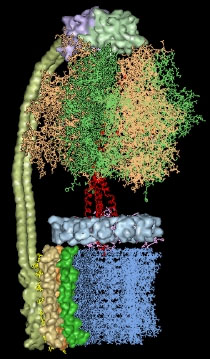Home > Press > Computer Models Explore Nano-Machines
 |
| Rotary motor ATP synthase manufactures ATP for the rest of the cell. Credit: Sun Lab / JHU |
Abstract:
"Most molecular motors operate on principles that are very similar to the way the engine in your car works," says Sean Sun, an assistant professor in the Department of Mechanical Engineering in the Whiting School of Engineering at Johns Hopkins University and an affiliated faculty member of the Institute for NanoBioTechnology.
"They consist of a flexible protein that performs an action when it burns a fuel molecule."
Computer Models Explore Nano-Machines
Baltimore, MD | Posted on November 13th, 2007But understanding how nano-sized machines function or how they create forces is not always this straightforward. "In any system in biology, 90 percent of it is unknown," Sun says.
Sun recently encountered many unknowns while conducting computational research on the biological forces generated during the reproduction of single cell organisms. Sun, doctoral student Ganhul Lan and colleague Charles Wolgemuth of the University of Connecticut, have described how a kind of molecular nanomachine called a Z-ring facilitates bacterial cell division.
The team published their findings in the Proceedings of the National Academies of Science (Oct. 9, 2007). According to report, the Z-ring produces enough force to pinch the rigid cell wall to initiate division and also helps localize the proteins needed to form a new cell wall between the daughter cells. Exactly how this force is generated is still a mystery.
"Our lab works on nanomachines of all different kinds," Sun says. "The Z-ring is a protein conglomerate ensemble (and) one of the interesting discoveries about the process is that very little force was required to do the job."
Solutions to the puzzles presented by nanomachines can be found by exploiting the synergy between computational models and experimental observations, he says. Sun also draws upon his prior training in chemistry and physics.
"Biology is making a tremendous transition from an observational science into a quantitative science," Sun says. "This is an area where I can really make a contribution"
Computational theories on molecule fueled nanomachines can be tested experimentally in labs like that of INBT's associate director, Denis Wirtz, professor in the Department of Chemical and Biomoleculuar Engineering. "With Denis, we are looking at many of the biochemical details to see if they match up to the computational models," Sun says.
Multidisciplinary collaborations initiated by INBT will shed light on these unknowns, Sun says. "Experiments are crucial in directing where your theories and modeling ought to goÖThey supply you with parameters. Even if you build equations, there are still unknowns that have never been measured. It is a synergistic process."
####
About Institute for NanoBioTechnology
The Institute for NanoBioTechnology at Johns Hopkins University will revolutionize health care by bringing together internationally renowned expertise in medicine, engineering, the sciences, and public health to create new knowledge and groundbreaking technologies.
INBT programs in research, education, outreach, and technology transfer are designed to foster the next wave of nanobiotechnology innovation.
Approximately 150 faculty are affiliated with INBT and are also members of the following Johns Hopkins institutions: Krieger School of Arts and Sciences, Whiting School of Engineering, School of Medicine, Bloomberg School of Public Health, and Applied Physics Laboratory.
For more information, please click here
Contacts:
* Institute for NanoBioTechnology
214 Maryland Hall
3400 North Charles Street
Baltimore, MD 21218
* Email:
* Phone: (410) 516-3423
* Fax: (410) 516-2355
Copyright © Institute for NanoBioTechnology
If you have a comment, please Contact us.Issuers of news releases, not 7th Wave, Inc. or Nanotechnology Now, are solely responsible for the accuracy of the content.
| Related Links |
![]() To learn more about the research under way in Sean Sunís lab, click here.
To learn more about the research under way in Sean Sunís lab, click here.
![]() To read Sean Sunís recent paper in PNAS, click here.
To read Sean Sunís recent paper in PNAS, click here.
![]() To read a recent article about this research from The JHU Gazette, click here.
To read a recent article about this research from The JHU Gazette, click here.
| Related News Press |
Molecular Machines
![]() First electric nanomotor made from DNA material: Synthetic rotary motors at the nanoscale perform mechanical work July 22nd, 2022
First electric nanomotor made from DNA material: Synthetic rotary motors at the nanoscale perform mechanical work July 22nd, 2022
![]() Nanotech scientists create world's smallest origami bird March 17th, 2021
Nanotech scientists create world's smallest origami bird March 17th, 2021
![]() Giant nanomachine aids the immune system: Theoretical chemistry August 28th, 2020
Giant nanomachine aids the immune system: Theoretical chemistry August 28th, 2020
Discoveries
![]() Chemical reactions can scramble quantum information as well as black holes April 5th, 2024
Chemical reactions can scramble quantum information as well as black holes April 5th, 2024
![]() New micromaterial releases nanoparticles that selectively destroy cancer cells April 5th, 2024
New micromaterial releases nanoparticles that selectively destroy cancer cells April 5th, 2024
![]() Utilizing palladium for addressing contact issues of buried oxide thin film transistors April 5th, 2024
Utilizing palladium for addressing contact issues of buried oxide thin film transistors April 5th, 2024
Announcements
![]() NRL charters Navyís quantum inertial navigation path to reduce drift April 5th, 2024
NRL charters Navyís quantum inertial navigation path to reduce drift April 5th, 2024
![]() Discovery points path to flash-like memory for storing qubits: Rice find could hasten development of nonvolatile quantum memory April 5th, 2024
Discovery points path to flash-like memory for storing qubits: Rice find could hasten development of nonvolatile quantum memory April 5th, 2024
|
|
||
|
|
||
| The latest news from around the world, FREE | ||
|
|
||
|
|
||
| Premium Products | ||
|
|
||
|
Only the news you want to read!
Learn More |
||
|
|
||
|
Full-service, expert consulting
Learn More |
||
|
|
||








